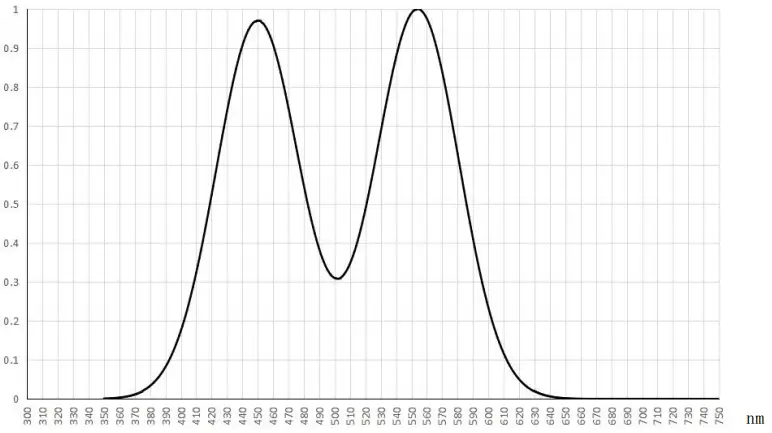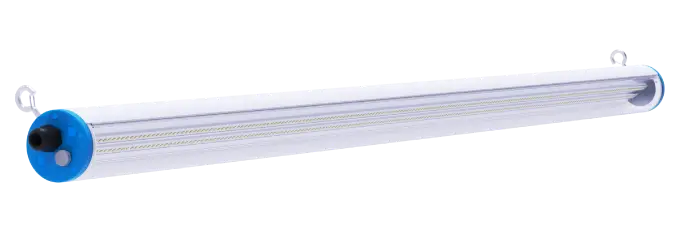Best LED Cattle Shed Lighting for Healthy and Productive Cows

Directory:
1. Visual Characteristics of Cattle Eyes
2. Scientific Management of Cattle Shed Lighting
3. Scientific Regulation of Barn Photoperiod
4. Best Cattle Sheds Light
Visual Characteristics of Cattle Eyes
Cattle have dichromatic vision, meaning they perceive colors differently than humans. Their eyes contain two types of cone cells:
Blue-sensitive cones (peak 450 nm)
Orange-sensitive cones (peak 554 nm)
Cattle have limited sensitivity to green and red light, so barn lighting must consider these spectral preferences for optimal visibility and minimal stress.
Red light (>650 nm): Appears nearly dark to cattle, ideal for low-disturbance inspections.
Green light (495–525 nm): Perceived as gray or black shadows, ineffective for detailed vision.
White LED lighting: High CRI is unnecessary; energy can be focused on intensity and uniformity.
Practical Tip: Use red-light sections in barns for night inspections without interrupting cows' rest cycles.

Spectral Sensitivity Distribution – Cattle vs Human Eyes
Scientific Management of Cattle Shed Lighting
Cattle instinctively seek shaded areas to avoid glare. Well-designed LED cattle shed lighting balances animal comfort, welfare, and farm productivity.
Optimal Light Intensity
Light intensity is critical for cattle behavior and feed efficiency:
| Zone | Recommended Lux | Notes |
|---|---|---|
| Feed alleys | 100–200 lux | Promotes even feeding and reduces competition |
| Resting areas | 50–100 lux | Avoids glare and stress |
| Night scotoperiod | <5 lux | Essential for melatonin production and rest |
LED Advantages:
Adjustable intensity for different zones
Energy-efficient, with precise spectral control
Supports gradual dimming to mimic natural dawn/dusk
Uniform Lighting for Welfare and Safety
Cattle have poor depth perception, especially in shadows. Non-uniform lighting can cause hesitation or injury.
Uniformity ratios: ≥0.8 in feed areas, ≥0.7 elsewhere
Diffused lighting: Reduces glare and shadow edges
Flicker-free LEDs: Prevent stress and aggression
Pro Tip: Install linear LED light fixtures above feed alleys and diffused panels in resting areas to maximize comfort.
Operational and Economic Benefits
Proper LED cattle shed lighting improves:
Feeding behavior: Better visibility increases intake by 5–10%
Health outcomes: Lower stress reduces disease incidence
Milk and meat yield: Studies show milk increase of 2–3 kg/cow/day with optimal photoperiod
Energy savings: LEDs consume 40–60% less electricity than conventional lamps
Scientific Regulation of Barn Photoperiod
Photoperiod management (light + dark cycles) of cattle barn lighting is critical for cattle physiology.

(Source: Group Standard for Technical Specifications of Cattle Shed Lighting)
Core Functions
Circadian control: Light period + dark period = 24-hour cycle
Scotoperiod: Supports immune function, reproductive hormones, and recovery
Physiological regulation: Influences growth, reproduction, bone development, and survival
Melatonin Mechanism
Light → Eye → Hypothalamus → Melatonin suppression, impacting:
Feeding behavior (directly improves milk yield)
Mammary gland development and lactation
Bone growth and nutrient absorption
Photoperiod Implementation Guidelines
Light Duration: Lactating cows 16–18 hrs (milk yield ↑ 5–16%)
Gradual Transition: 30–60 min sunrise/sunset simulation
Intermittent Light: Segmented cycles (e.g., 4h light + 2h dark) for energy efficiency
Implementation Tip: Use programmable LED systems to automate light schedules for maximum efficiency.
Best LED Cattle Shed Lighting Products

LED barn light T21 – engineered for modern barns:
IP68/IP69K rated: Resistant to water, dust, and high-pressure cleaning
Ammonia-resistant materials: Suitable for high-ammonia barn environments
Adjustable spectrum: Optimized for cattle’s blue/orange sensitivity
Dimmable & programmable: Supports photoperiod and gradual light transitions
Case Study: A dairy farm in the Netherlands installed T21 LEDs across a 500-cow barn:
Milk yield ↑ 2.5 kg/cow/day
Feed consumption more uniform
Energy consumption ↓ 50% compared to fluorescent lamps
